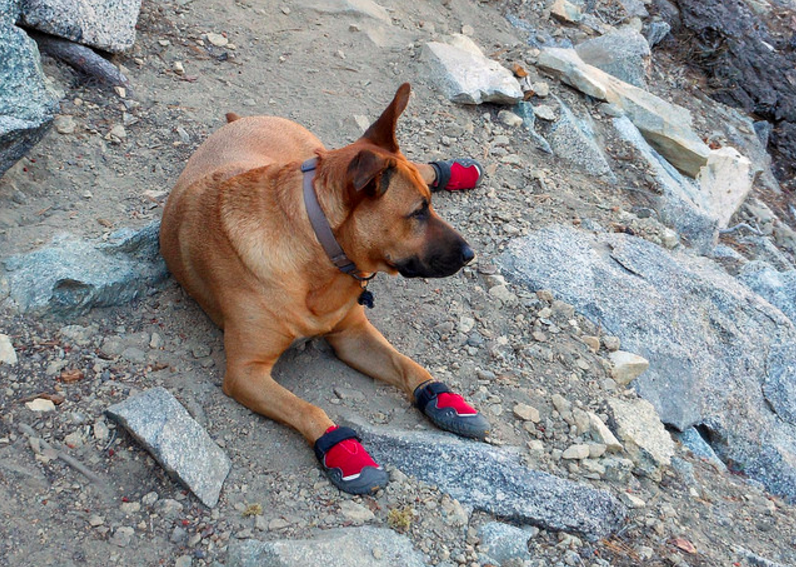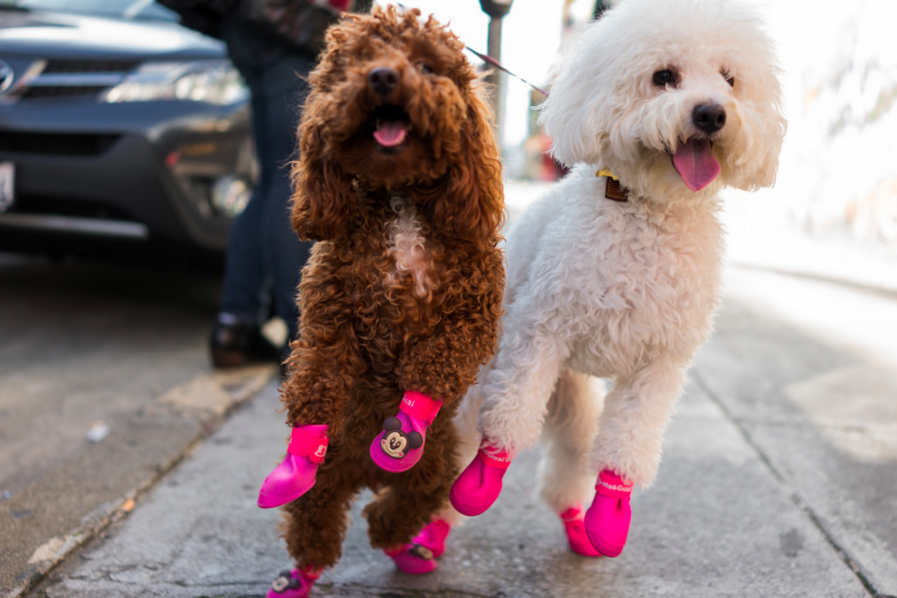The best dog boots for summer and hot weather

Because we live in Southern California, my dog and I spend the majority of our free time outside, particularly on warm summer days.
I don’t take being a dog-parent lightly, either, so I always consider all of my pup’s needs and wants when leaving the comforts of home.
On a recent trip to the park, though, I learned that I was oblivious to one of the most important things to consider: paw protection.
After just a few blocks, I started feeling uneasy about the hot pavement, and I promptly drenched my 90-pound Labrador in my personal supply of drinking water to keep him from overheating.
When we returned home I noticed the pads of his paws were bright red and peeling. I felt like I had failed my dog, and more importantly his paw pads.
While I was taking the appropriate steps to heal his paws, I knew I had to find a way to prevent this from happening again. The answer to my problem was almost too simple, yet completely surprised me. Dog boots!
What are dog boots?
Though a lot of people consider dog boots to be a purely aesthetic purchase, dog boots were actually invented to protect the paws of some of the world’s most adventurous pups: sled dogs.
As the needs of the household pet have changed over time, however, dog boots have been adapted to protect the paw pads of the everyday dog as well.
So, what are dog boots? They are essentially shoes for your dog. Like human shoes, different types of dog boots, serve different purposes. From protecting your dog’s paw pads from hot pavement to breathability, and durability. There is a dog bootie for every purpose.

Keep your dog’s paws feeling great with dog boots. Image: vhines200
Why should you consider dog boots?
As more dogs are accompanying their owners on outdoor adventures, dog boots are increasing in popularity. This is largely due to their functionality, but also because they offer dog owners peace of mind.
A happy pup is a safe pup. There are a few reasons you should consider dog boots when considering the safety and comfort of your dog.
Change in environment
Most everyday dogs don’t have demanding jobs. They are not routinely scaling mountains or walking on hot cement. Their daily routine consists of some variation of sleeping on the soft, indoor carpet; sprawling out on cool, wet grass; or anxiously waiting for you from the comforts of your bed.
More than likely, your pup’s paws and pads aren’t built for more extreme elements or terrain. Like most of us, they haven’t developed callouses from a harsh environment. Fortunately, you can still enjoy all of the things you love, from Netflix to camping during a hot summer weekend by the lake; dog boots help protect your pup’s pads from this drastic change of environment.
Wear and tear
It doesn’t always take a drastic change in the environment to cause injury to your pet’s paws. Have you ever unexpectedly stubbed your toe or stepped on something sharp? Chances are, your dog has too.
If you’ve ever looked at the bottom of your dog’s paws, you’ll notice that there are very tender spaces in between their pads, a space that is comparable to the soft space in-between human toes. Left unprotected, rocks, sticks, or other objects could become lodged in these spaces, causing pain or injury.
Puppies and senior dogs are also more susceptible to cuts, scrapes, or paw injury because their paws are either undeveloped or worn down with age. A dog boot is a great way of protecting vulnerable places on your dog’s paws.
Veterinarians will also use dog boots if a pet has had a recent injury and their paw needs to be protected from infection or further injury.
Weather
As I mentioned, the first dog boots were used by sled dogs in extreme winter climates. The contemporary dog boot serves the same purpose, but for all weather climates. Whether you intend to be out in the rain or on hot summer days or to spend time outdoors in the winter, there is a dog boot crafted to protect your dog’s paws. There are even options for hardwood floors!
In winter climates, specifically, weather can really take a toll on a dog’s paws. Snow can build up in the area between their pads, stick to their fur, and under extreme conditions can even cause cuts and abrasions. In order to ward off injury, dogs living in colder climates would benefit from the protection of a dog boot.
We don’t get harsh winters in Southern California, so we only use snow boots when on winter trips. However, I’ve found that waterproof dog boots are very useful when we get a lot of rain and I have to take my dog out to trek in the mud. In these situations, it’s nice to have more traction to keep my dog from slipping or getting stuck in the mud. As an added bonus, when we return home, my dog’s paws aren’t covered in dirt or debris, which means my home isn’t either.
On hot summer days, dog boots are a great lightweight option to keep your dog from injuring their paw pads on hot cement or asphalt. This injury is so common. For me, it’s very simple. If you live in hot weather and have a dog, you should find a breathable boot to protect your dog’s paw pads from dangerously hot surfaces.
Regardless of the varying weather climates, dog boots will function to protect your pet and enable you to continue your daily activities with your best furry friend.
Injury
Dog paw and leg injuries are uniquely challenging because, in order for them to fully heal, you have to keep your dog from doing what he loves most: walking!
When my dog injured the pads of his feet, I had to do my best to keep them clean and free of infection. Unfortunately, that meant an almost-hourly game of wrap, clean, and “don’t lick.” I was nervous to take him outside, nervous to let him walk; I was just nervous, all the time.
However, after reading reviews and purchasing dog boots, I realized that a lot of people actually use boots to help their dogs recover from injury.
Dog boots will keep your dog’s wound or injury clean, keep your dog from licking or scratching, and has the added bonus of being super low-maintenance. They also offer your dog a lot more freedom, because they can be used outdoors, where an injury might otherwise become infected.
This means more walks for your dog and more peace of mind for you!

Your dog may not like boots at first, but they’ll get used to them. Image: Rob Sheppard
Performance
As I mentioned, dog boots were invented to meet the needs of the most adventurous dogs working in the most extreme elements, but extreme sled dogs are not the only working dogs that benefit from dog boots.
Working dogs often have the most challenging circumstances to endure. By working dog, I don’t mean a dog that works a 9-5, either. Working dogs can mean a variety of things: dogs that hike, camp, backpack, run or regularly participate in any type of demanding activity. These types of dogs put a lot of strain on their paw pads.
In fact, service dogs are one of the most common types of working dogs you will see sporting dog boots. Why? For one, they are working 24/7 and endure just about every type of walking surface and weather there is. But also, dog boots have been shown to enhance their performance.
Tips for finding the right dog boot
In order to avoid frustration, it’s important to take the time to find the right dog shoe/boot for your dog and your lifestyle. There are a few things to consider when trying to find the best possible boot for your pup.
Lifestyle
When looking for the perfect dog boot, you’ll want to ask yourself one question: “Where will my dog use these?” The answer to this question will determine the type of dog boot you’ll need. Though some dog boots offer more versatility, you’ll want to note key qualities and whether they’ll work for your intended use.
For example, if you’re looking for a boot to use in warm weather, you’ll want to consider boots that offer breathability and are more lightweight. If you’re looking for a boot that can withstand harsh winters or extreme environments, you’ll want to find a boot that offers a more durable sole and extra traction.
Also, worth noting, most boots on the market today use Velcro to secure them to your dog’s foot. However, some offer reflective Velcro, which is great for late-night activities (e.g., hiking or running at night).
Proper fit
I cannot emphasize this enough. Size and fit matter. Even if your dog is the most well-mannered, easy-going dog on the block, if the size of their boots is wrong, your pup will be either kicking the boots off every half-block or hiding under the bed when it comes time to put them on.
There are a few methods that you can use to determine the correct fit and correctly measure your dog’s paws, but the best advice I can offer you is to review the manufacturer’s specific recommendations for taking measurements. Though several strategies will work for basic paw measurements, each product has been reviewed, tested and will offer a product-specific recommendation for sizing.
Remember, the proper fit will be the difference between a positive or negative first impression with your pup and first impressions are critical.
Materials
Not all boots are made equal. Some boots are made of rubber, plastic, suede, nylon, or fleece. Ruffwear even uses its own proprietary form of rubber called Grip Trex. Be sure to look closely at the materials that make up each part of the dog boot. Some companies have been known to skip rubber soles as a cost-cutting measure.
Though materials differ, most of the functionality remains the same, so it’s important to determine which material is best for your intended use.
If you are using the boots for long periodic walks or to protect from hot summer days, you’ll want to consider a material that is more lightweight and breathable. While breathability
If your dog will be doing a lot of outdoor hiking, running, or spending time in extreme environments, you’ll want to consider materials that are heavier, more durable, and offer more grip and traction. For hiking purposes specifically, I always focus on the strength of the velcro straps, how waterproof the material is, and the amount of traction offered.
Another thing to consider when finding the perfect boot is finding a material that maximizes comfort. Harder, more coarse materials should be used for rugged activities and vice versa.
If you decide on a soft material for a rugged activity, you will be replacing the boot more frequently. Conversely, if you choose a tougher boot for a more leisurely activity, your dog may be less inclined to adapt to their new shoes.

Match your boot materials to why your dog needs them. Image: chickenscrawl
The best dog boots for summer
There is a lot of information out there about dog boots and selecting the right boot can be a lengthy process. To help you through his process, I’ve narrowed down my personal favorite dog boots for summer.
What to look for:
- Fit
- Durability
- Breathability
- Being water-resistant or waterproof
- Strong Velcro straps
- Traction and grip
- Constructed with high-quality materials
Ruffwear Grip Tex
Ruffwear is one of the industry’s leading brands for outdoor/adventure products for pets. I first stumbled on these boots at my local REI and was immediately drawn to the design and versatility these had to offer.
From my research, I noticed that Ruffwear was a top competitor when it came to all-terrain options for dog boots. In fact, some have said they set the standard in paw wear. Similar to Canine Equipment boots, Ruffwear is a high-performance boot created for a variety of harsh and diverse climates.
The Ruffwear dog boot is an excellent option for all types of adventurers and is frequently used by bicyclists, runners, and hikers. Ruffwear uses a breathable mesh on the upper portion of the boot, similar to Canine Equipment, which offers breathability and comfort.
On other portions of the boot’s construction, Ruffwear’s proprietary material Grip Trex is used.
Unique to this boot, is a hook-and-loop cinch-closure system that offers more dependability than a standard velcro strap. This keeps the boot in place and enhances comfort during longer durations of intense activity.
For those that are looking for a balance of functionality and aesthetics, I found this boot to have the most diversity in terms of colors and style. They offer a Blue Spring, Red Currant, and Black, so you can find the shoe that best fits your pup’s personality. They also offer a reflective band to make sure visibility is not a concern.
Similar to the Canine Equipment Boot, it’s extremely important that you pay close attention to sizing requirements. Different sizes may be required for your pet’s front and hind paws, so using Ruffwear’s sizing chart will help you measure and fit your dog with the right size boot.
I found this article to be very helpful when breaking in a pair of Ruffwear Grip Tex Boots. Because sizing is so important in the overall comfort of a dog boot, Ruffwear also created a video that helps you understand how to properly measure your dog’s paws.
Here’s what customers have to say about the Ruffwear Grip Tex, All-Terrain Paw Wear For Dogs:
Pros:
- Highly durable
- Not clunky
- Love the diversity of color/looks
- Great for heat/asphalt
Cons:
- High price
- May not be suitable for dogs with dewclaws
- Sizing is not always accurate
- The Interior is not lined and may require socks
You can buy the Ruffwear Grip Tex Booties at Amazon.
Canine Equipment Ultimate Trail Dog Boots
Canine Equipment is a reputable brand that prides itself on making a variety of durable outdoor pet products. These dog boots are a great option because they check all the boxes for a variety of lifestyles and uses.
They are listed as an all-terrain boot, which means they’re a great option if you’re looking for versatility. They are also made from a durable rubber material, so they will maximize protection in a variety of tough terrains.
In addition to being all-terrain, they are great for all-season use. For me, this is a huge advantage, because I won’t have to buy several different types of boots for different weather.
Though our weather is moderate in Southern California, I like the option of being able to take these boots with me if we travel to harsh climates. This reduces the amount of time I spend having to acclimate my dog to different boots and also helps save on cost.
The Canine Equipment Ultimate Trail Dog Boot boasts a design that maximizes comfort. Though it is durable, Canine Equipment has used an expandable, soft upper shell to optimize flexibility in your pet’s paw.
As a fun perk, they have reflective accents to keep your pup safe during nighttime play!
One of the most important things to note is that these boots are sized differently for front and hind paws. This maximizes comfort and functionality, but you will want to carefully review the sizing instructions to make sure you get the right fit. To make this process easier, take a look at this video:
Here’s what customers have to say about Canine Equipment Ultimate Trail Dog Boots:
Pros:
- Extremely durable
- Non-slip traction
- Highly recommended for outdoor activities
- They stay on
- Easy to put on
- Great airflow for warmer days
- Incredibly versatile, used for all climates
Cons:
- Velcro could be longer
- Soles can wear out quickly
- Protective rubber may be too stiff
You can purchase Canine Equipment Ultimate Trail Dog Boots at Amazon.
How to adjust your dog to wearing boots
Putting the shoes on
If you’re anything like me, you’re probably thinking this part is easier said than done. However, after the first couple of times with the right technique, your dog will adjust and this process will get much simpler.
For me, getting my dog to stand up on all four legs so his weight was evenly balanced was the key. When first introducing your dog to dog boots, I found it helpful to solicit help from a friend or family member, to keep my dog preoccupied.
Another technique is to train your dog to stand on command. Though this method takes some pre-planning and training, it can be a handy training tip to make this process easier overall.
Once your dog is standing, the rest of the process is similar to putting on a regular shoe. (If you have put shoes on a child, you have the upper hand.) Gently slide the shoe into place, guiding your dog’s foot into the boot, and feel the interior of the shoe to make sure your dog’s paw is completely in place. If your dog has long hair, you’ll want to move excess hair from areas where the shoe is fastened together.
Once the boot is fastened, celebrate with a treat or some extra love (more on this below). Take care not to overdo the excitement, however, or your dog may get too excited for you to put on the other three boots.
Don’t be alarmed if your dog’s first reaction is to try and kick the shoes off. If you have found a dog boot with the proper fit, they should stay on.
It’s normal to expect a strange reaction from your dog. After a while, with your help and encouragement, they should adjust!
Positive reinforcement
The easiest method for getting your dog used to wearing a dog boot is by using comfort items and/or treats.
Start by allowing your dog to get acclimated to the boots before you try and put them on. Do not expect your dog to be ready for a standard length walk right away.
Place the boots on the floor in a comfortable area, like a dog bed or the living room floor. When your dog approaches them, give them a treat or a favorite toy. The duration of this process largely depends on the dog, but eventually, your dog will start to associate the boots with treats, toys, and love.
Don’t try to move too quickly or assume your dog will react a certain way. In doing so, you will inadvertently prolong your dog’s adjustment period.
Once the dog boots are on, prepare to be amused. Most of the time, your dog will shake them around or walk awkwardly like they are tiptoeing through the house. During this time, it will be tempting to reinforce your dog with more attention or a treat, but be cautious. Reinforcing your dog while they are trying to remove the boots will be reinforcing the wrong behavior.
During this time, it’s best to help your dog remain calm and comfortable. If you can contain your laughter, it’s best to act like nothing is happening and allow your dog some time to get used to their new wardrobe.
Engage in fun activities
If you’ve followed the steps above, you’ve already helped your pup by getting them acclimated to the boots in a comfortable and familiar place. The next step is to associate the boots with fun!
If possible, play a game of fetch in your backyard, take your dog on a short walk or invite their favorite playdate over for a friendly neighborhood game of tug-o-war. The goal is to get your dog’s attention off of the boots and distract them with something they enjoy.
You can progressively increase the duration of the activities or include more vigorous activities once you feel your dog is less concerned about the boots and more focused on the activity at hand.
So, contrary to what you might have thought about dog boots, they aren’t just reserved for cute chihuahuas and the dog-elite. Though they might spice up your dog’s ensemble, dog boots are truly a functional item that helps protect your dog’s paws and pads.
Although my dog wasn’t initially enthusiastic about the addition to his wardrobe, after a while he started to associate them with all of his favorite activities. So, even though he isn’t able to verbally thank me, I can see his gratitude through his ability to happily experience the outdoors pain-free.
Feature image: Mitch Barrie



